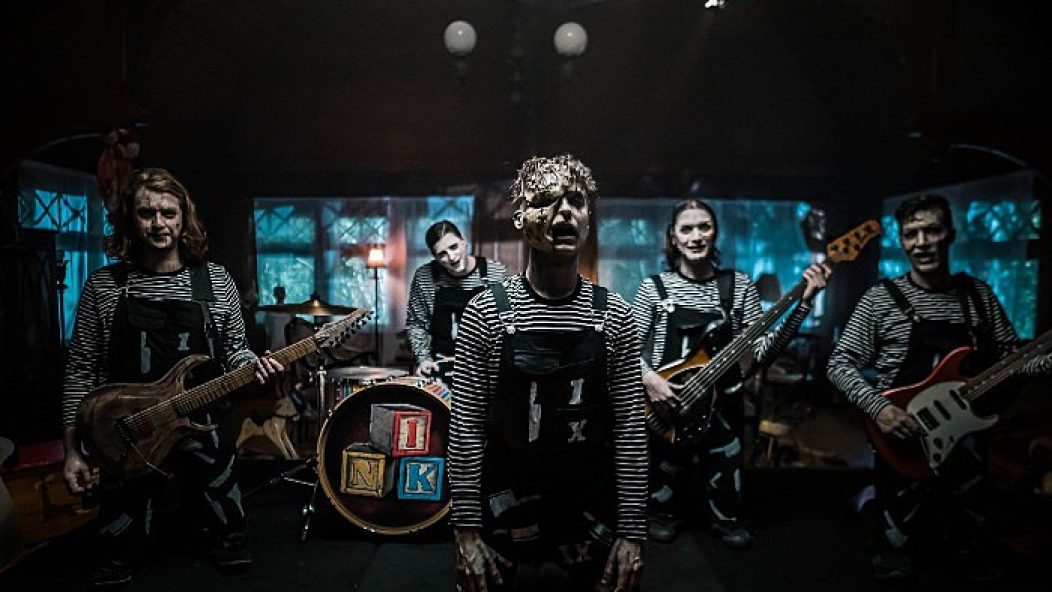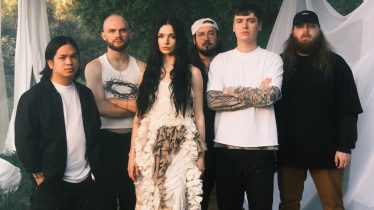
Ice Nine Kills on upping the body count with 'The Silver Scream 2'
Ice Nine Kills have dropped their latest album, The Silver Scream 2: Welcome To Horrorwood via Fearless Records. Ahead of the release, Alternative Press spoke to frontman Spencer Charnas about the new project.
With The Silver Scream 2, the band constructed a perfect horror sequel to the first entry in the series. The new album deepens their commitment to the genre, doubling down on the energy, the scope of the effects.
Read more: DED’s ‘School Of Thought’ calls for self-reflection and healthy living
“In Scream 2, Randy points out that the body count is always bigger,” Charnas explains. “The production is upped on every level. There’s more recording budget or filming budget. We went in with that lighthearted attitude that we were going to have fun and see how much crazier we could take this newfound style of taking horror movies and converting it into the Ice Nine Kills treatment.”
During our interview, Charnas also discussed the record’s broad musical styles, the many cameos that helped create the dynamic release and the band’s relentless commitment to forging their own path.
I wanted to start by asking you about the themes and goals for the record. This is obviously presented like a sequel movie.
As a big horror fan, part of the history of this genre—especially late ‘70s [and] ‘80s slasher movies—is that if there is a successful film, there’s always a sequel. Going into the album with that mindset is really where I wanted to take the album. In Scream 2, Randy points out that the body count is always bigger. The production is upped on every level. There’s more recording budget or filming budget. We went in with that lighthearted attitude that we were going to have fun and see how much crazier we could take this newfound style of taking horror movies and converting it into the Ice Nine Kills treatment.
We also wanted to take it up a notch on the storytelling side of things through the music videos that are tied to this album. Basically, our new story accepts the last album and the last video series from Silver Scream 1 as a work of fiction. The authorities are trying to use that previous album, as well as this new album, which was never meant to be heard, as evidence of my guilt for committing this actual murder in reality, so to speak.
It really does feel like you opened up a lot with this release. The sounds, the concepts, everything.
A lot of it has to do with the reaction from the first album. As soon as we put out Silver Scream 1, people seemed to love it. But they also said, “Oh man, you got to do this movie. What would it sound like if you gave Child’s Play or American Psycho the treatment?” In a lot of ways, it’s also a love letter to our fans, to give them exactly what they wanted. I think because we had a little bit of success with the last album, it also gave us a license to take even bigger risks. Our fans are so cool that they’ve come to expect those left turn moments.
We’ll start a song, and it’s very soft and melancholy. It’s almost a piano ballad vibe. Then, we slam into this raw death-metal part. At the core of what we were trying to do is really accentuate the music to really mimic and give the audience the feeling of being inside those movies. A song like “Assault & Batteries” about Chucky—it’s just balls-to-the-wall craziness just like the characters. Whereas a song like “Farewell To Flesh,” which is about Candyman, has really heavy moments like the brutality of the film but also has almost dark romantic piano moments. I think that that sort of juxtaposition has always been part of what Ice Nine Kills does. That calm before the storm.
I also really feel that juxtaposition when it comes to all of the extra-musical vignettes and other effects on the record. Did you decide to expand upon the previous album in that sense as well?
I think all that stuff happened naturally. For me, it’s just fun. Something that people don’t get about our band is that it’s dark, it’s scary [and] it can be violent. But also there is an element of humor to a lot of the songs, just like the movies have that element of humor. I think that some people might not get that on first listen, but as much as I’m influenced by horror movies, I’m also influenced by Christopher Guest movies like Waiting For Guffman and A Mighty Wind. There’s obviously a musical element, but there’s a comedy to it.
That’s why I always think it’s funny when someone criticizes the band like, “This is cheesy.” I’m like, “Dude, no fucking shit! What the hell do you think we’re trying to do? Make Citizen Kane?” We’re just having fun with it. Horror movies, a lot of the ones I like, are cheesy. Obviously, the music is going to reflect that.
Another way you’ve really turned up the cinematic quality is with how many collaborations and cameos you have attached to the project.
There’s some really cool cameos in the music videos that we pulled from the world of horror. We have Bill Moseley as the captain of the police. He’s the star of all the Rob Zombie movies like House Of 1000 Corpses and The Devil’s Rejects. He’s such a class act! Ricky Dean Logan, who is in Freddy’s Dead: The Final Nightmare, plays my lawyer. [I’m] also a big fan of Seinfeld. He was in one of my favorite episodes, “The Keys.” It was great to get people like that involved in The Silver Scream universe.
One of the most ironic cameos I’ve ever heard of in anything was our upcoming video for “Funeral Derangements,” which is based on Pet Sematary. We got the actor who played the little boy that gets hit by the 18-wheeler to play the truck driver that hits the little boy in our homage. Talk about a full-circle moment, where he’s actually sort of killing himself. That actor’s name is Miko Hughes. He’s a great actor. You’d recognize him from a million things from that era like Kindergarten Cop, Apollo 13, New Nightmare—the last Nightmare On Elm Street film if you don’t count Freddy Vs. Jason.
We have so many great cameos from bands that I’ve looked up to over the years, like Buddy [Nielsen] from Senses Fail on, Brandon [Saller] from Atreyu, Corpsegrinder from Cannibal Corpse, Ryan from Fit For A King and, of course, Jacoby [Shaddix] from Papa Roach in “Hip To Be Scared” playing Paul Allen. It’s one of those things where it’s such an honor to have people that you look up to involved in your own project, and that’s very cool to me.
The other thing that really jumps out to me about the record is the contrast of genres. I think of INK as a band that’s always been musically broad, but I’m wondering what drives that aspect of your music.
I just like a lot of different genres—I love the idea of being able to get away with doing a really heavy song and then a really soft song. That just goes back to what I was saying about our fans being so cool about us dabbling in a bunch of different other stuff. Not every song has that screaming. Not every song has to break down for it to hit hard. We’ve just gotten comfortable because our fans have showed us that they’re comfortable with not having to stick to a certain level of heaviness. Our fans have showed us that as long as the song is good, they’re going to like it no matter what genre it is.
I’m sure an element of that is also about doing what you enjoy. I really see that aspect when it comes to the videos you make. Is a partial aspect of taking on those roles just about getting to revisit the things you love?
Oh yeah. I was always the kid among my friend groups that knew all the words to these movies, and I would quote it endlessly to probably very annoying lengths. For “Hip To Be Scared,” which is an American Psycho love letter, I’ve been practicing that speech for 20 years. The only difference is this time the camera’s rolling. I can’t believe that I get to do this stuff as my job. I’m really lucky that I get to do that because, at the end of the day, it’s so much fun, even though sometimes the hours are long and we do sometimes overnight shoots in these remote places where dust is blowing into my face and I’m covered in blood and being dragged through a forest. At the end of the day, I just have to remind myself that this is a good job.
I know everyone is asking this question these days, but I wondered about the COVID factor in making the record. The shutdown has really affected artists, some for the better and some for the worse, so it’s hard to bypass it.
This record, honestly, was the easiest, most relaxing process I’ve ever experienced in terms of working on a record. Obviously, with any album, there’s deadlines, and at the end of the process, we got down to just the wire to make the release date that we wanted to make. But as shitty as the pandemic was, the best possible thing from it—if we could take one terrible tragedy and at least try to find a silver lining in it—was that we had a year off to write an album, and that’s something that we just don’t get usually.
It’s usually fitting it in between tours and having to reschedule studio time because the tour opportunity came out. This is the first time we got to just sit down and work on a record pretty much front to back. I think the only song I had written for the record prior to that was “Hip To Be Scared.” The entirety of the record other than one song was written and recorded during the pandemic. It was just a really stress-free process, and I think that’s why I think it’s the best album we’ve done. I think there was a time to get everything just right.
You worked with Drew Fulk again on this record. What is it like working with him?
He’s become another member of the band, just like Steve Sopchak, who I write all the lyrics with. Drew [has] become a really good friend of mine. We hang out even when we’re not working on a record, and there are so many things, so many positive qualities that he possesses as a producer. One of my favorite things about Drew is that he’s not scared to take risks. He’s not a suit. He’s not like, “How do we make this song a radio hit?” It’s just, “How do we make this song the most creative, cool, catchy piece of art that we can make? How do we do it different?”
I think that kind of mentality works perfectly with our mantra to not follow the trends. If we see a trend forming, we both want to run the other direction. I think that that’s a mistake a lot of bands make, and it’s a mistake that we used to make back in our earlier years. We were too concerned about what other bands were doing, the popular kids [in] the cafeteria, where they were sitting. As soon as we stopped giving a shit about that, that’s when we started to become more popular. If there’s anything to learn from us, it’s don’t follow the trends. You might have success in the short term, but you don’t want to be one of those flavor of the week bands that just sounds like everybody else.
To Learn more about The Silver Scream 2, read our profile on the new record in AltPress issue 399, available for purchase here.








